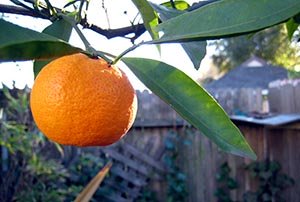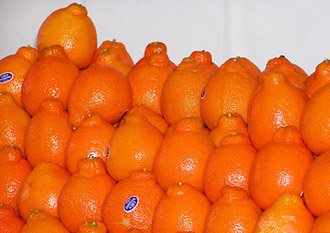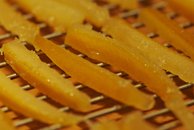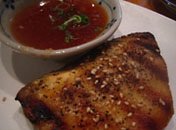Tangerines nutrition facts
Tangerines are a variety of citrus fruits and closely related to Oranges. They are distinguished from oranges by their smaller size, loose, easily peelable skin (pericarp), and sweeter juicy flesh (arils).
They also known as mandarin oranges in Europe. In Japan, a closely related seedless variety of mandarins known as Unshu mikan or satsuma mandarin is grown in abundance in Kagoshima prefecture. Just as in oranges, mandarins also belong to the Rutaceae (Citrus Family) and are known scientifically as Citrus reticulata.
 |
| Tangerine (Mandarin). Note flat, deep orange, well-ripe fruit. Its deciduous leaves feature conical tips. Courtesy: orphanjones |
Mandarin oranges are thought to have originated in South-Eastern tropical forests of China. Today, it is widely grown in many parts of the world, as far as California, the Philippines (Dalanghita), and South Africa (naartjie in Afrikaans) as an important commercial crop.
Tangerine tree is smaller than orange, with slender branching and foliage-deep-green leaves with pointed ends. The fruit is flat, and small compared to "Navel" or "Valencia" oranges. Its loose, deep-orange color skin (pericarp) can be peeled rather easily. Inside, it features an extensive fibrous pith, which is loosely attached to the inner skin and edible arils. An average-sized fruit has 8-10 juicy segments (arils).
 |
| Tangelos. Note deep-orange color fruits with a nipple-like knob at the top end. Photo: Muffet |
Several hybrid varieties of tangerines exist:
Tangelos, also known as honeybells, are a hybrid between tangerine and orange (Citrus sinensis) or grapefruit (Citrus paradisi). Tangelos, like tangerines, have loose skin and juicy sweet-flavored arils. They are distinguished from oranges by a characteristic knob at the stem end of the fruit.
Tangors (Citrus nobilis) are a cross between oranges (C. sinensis) and tangerine (C. reticulata). They feature a large size, and sweet-tart flavor similar to oranges.
Clementines, another member of the citrus family, are a hybrid between mandarin and sweet oranges. They are smaller, have smooth, glossy skin, and very sweet, juicy, almost seedless segments.
Yuzu fruit or Japanese citrus fruit is a hybrid between C. ichngenesis and mandarin oranges (C. reticulata). They characteristically have an intense lime-like fragrance and tart flavor.
Health benefits of Tangerines
Visit here to find health benefits section of Oranges.
As in oranges, Tangerines too are very low (53 calories/100 g) in calories. Nevertheless, they compose valuable sources of flavonoid antioxidants like naringenin, naringin, hesperetin, vitamin-A, carotenes, xanthins, and lutein, in fact, several times higher than in oranges.
Also, tangerines are very rich sources of vitamin-C (ascorbic acid), a water-soluble vitamin. Vitamin C is one of the powerful natural antioxidants, that plays a vital role in collagen synthesis, wound healing, antiviral, and anti-cancer activity, and helps prevent neurodegenerative diseases, arthritis, and cold/fever by removing oxidant-free radicals from the body.
Vitamin-C helps in the absorption of iron in the food by reducing it from ferrous form to efficiently absorbing ferric form in the gut.
Further, they contain natural soluble and insoluble fiber like hemicellulose, pectin, etc., which prevents cholesterol absorption in the gut. Adequate fiber in the food aids in smooth bowel movements by acting as a laxative.
Citrus fruits have long been valued for their wholesome, nutritious, and antioxidant properties.
Moreover, nutrition scientists now begin to appreciate the benefits of other biologically active non-nutrient compounds such as dietary fiber and phytochemical antioxidants in citrus fruits. Soluble and insoluble dietary fibers play a vital role in the reduction of risk factors for cancers, and many chronic diseases like arthritis, obesity, and coronary heart diseases.
| Principle | Nutrient Value | Percent of RDA |
|---|---|---|
| Energy | 53 Kcal | 2.5% |
| Carbohydrates | 13.34 g | 10% |
| Protein | 0.81 g | 1.5% |
| Total Fat | 0.31 g | 1% |
| Cholesterol | 0 mg | 0% |
| Dietary Fiber | 1.8 g | 5% |
| Vitamins | ||
| Folates | 16 µg | 4% |
| Niacin | 0.376 mg | 2.5% |
| Pantothenic acid | 0.216 mg | 4% |
| Pyridoxine | 0.078 mg | 6% |
| Riboflavin | 0.036 mg | 3% |
| Thiamin | 0.058 mg | 5% |
| Vitamin C | 26.7 mg | 44% |
| Vitamin A | 681 IU | 23% |
| Vitamin E | 0.20 mg | 1% |
| Vitamin K | 0 µg | 0% |
| Electrolytes | ||
| Sodium | 2 mg | <0.5% |
| Potassium | 166 mg | 3.5% |
| Minerals | ||
| Calcium | 37 mg | 4% |
| Copper | 42 µg | 4.5% |
| Iron | 0.15 mg | 2% |
| Magnesium | 12 mg | 3% |
| Manganese | 0.039 mg | 1.5% |
| Zinc | 0.07 mg | <1% |
| Phyto-nutrients | ||
| Carotene-ß | 155 µg | -- |
| Carotene-α | 101 µg | -- |
| Crypto-xanthin-ß | 407 µg | -- |
| Lutein-zeaxanthin | 138 µg | -- |
| Lycopene | 0 µg | -- |
Selection and storage
Tangerines are winter-season fruits. However, one may find them in supermarkets all around the year, thanks to advanced storage technologies. Buy fresh fruits featuring bright orange color and feel heavy in hand. Avoid fruits with spots, excessively softened, or feel “hollow” in hand.
Commercially, citrus fruits are washed and waxed to extend their shelf-life, appearance, and market value. It is safe to use them. However, choose carefully, since oftentimes their defects may be disguised by wax.
Once at home, store them in a zip pouch and place them inside the refrigerator where they keep well for up to a week. However, eat as early as possible to enjoy their rich flavor and nutrition benefits.
Preparation and serving methods
Tangerines come with natural peel, which makes their edible arils well-preserved from contamination. Just clean with a moist absorbent cloth to remove any surface dirt and wax. Peel the skin with your hands, remove the pith, and separate segments. Seedless Mandarine/ Clementine segments can be readily eaten.
Just as in other citrus fruits, squeeze the seeds out after making a small snip on the inner side of the aril at its center. Although it is harmless to eat seeds, their bitter taste makes them inedible.
Here are some Serving tips:

|

|
| Candied orange peels. Courtesy: grongar | Ponzu sauce over grilled mackerel. Courtesy: Rick |
As in oranges, tangerines can be eaten on their own without any additions.
Tangerine juice is a healthy refreshing drink. It is employed in syrups, sauces, marinades, concentration, etc.
Its juicy segments add richness to fruit/green salads.
Tangerine zest imparts distinctive orange flavor to confectionary items such as biscuits, cakes, muffins, pastry cream, ice creams, etc.
Yuzu juice and its zest is an essential ingredient in traditional Japanese cuisines such as ponzu sauce and ponzu shoyu (with soy sauce), with fish as a marinade.
Its skin (pericarp) can be candied as in oranges.
Safety profile
Insecticide sprays are applied widely over citrus crops. Therefore, it is recommended to wash the fruits in cold running water before use. Organic fruits are devoid of these chemicals and are best suited for zest preparation. (Medical disclaimer).
≺≺ Back to Fruits from Tangerines. Visit here for an impressive list of all varieties of fruits with complete illustrations of their nutrition facts and health benefits.
≺≺ Back to Home page.
Further reading and Resources:
Stanford School of Medicine Cancer information Page- Nutrition to Reduce Cancer Risk.
JN-The Journal of nutrition- The Hypoglycemic Effects of Hesperidin and Naringin Are Partly Mediated by Hepatic Glucose-Regulating Enzymes in C57BL/KsJ-db/db Mice.